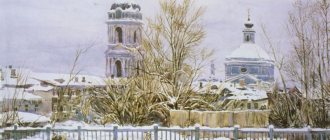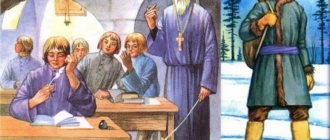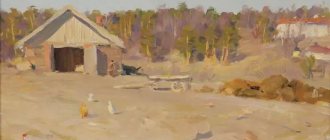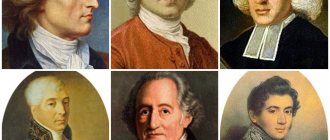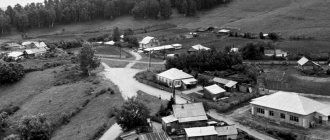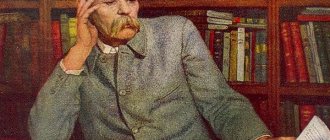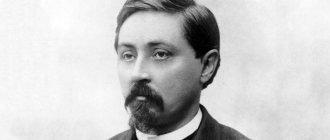December 1, 1913 – May 6, 1972 (58 years old)
4.8
Average rating: 4.8
Total ratings received: 1302.
Dragunsky Viktor Yuzefovich (1913–1972) - prose writer, poet, classic of Soviet literature, author of the famous children's series "Deniska's Stories". He is best known for this series of kind, witty and instructive stories for children.
The material was prepared jointly with a teacher of the highest category, Kuchmina Nadezhda Vladimirovna.
Experience as a teacher of Russian language and literature - 27 years.
The beginning of creative activity
Viktor Yuzefovich's family was in a difficult financial situation, so he had to go to work early. Since 1930, Dragunsky began to attend the “Literary and Theater Workshops” of A. Dikiy. In 1935 he was accepted into the troupe of the Transport Theater (now the N.V. Gogol Theater). Later, Dragunsky worked in a circus, and for some time played at the Satire Theater.
In addition to the theatre, Viktor Yuzefovich was attracted to literary activity; he wrote humoresques, sideshows, feuilletons, skits, circus clowneries, etc. In 1940, Dragunsky’s works first appeared in print.
In 1945, Viktor Yuzefovich was invited to work at the Theater-Studio of Film Actors. In 1947, Dragunsky, whose biography was not full of film roles, starred in the film “The Russian Question” directed by M. Romm.
Brief biography of V. Yu. Dragunsky
The difficult life path of Dragunsky.
Viktor Yuzefovich Dragunsky is a Soviet writer, author of numerous children's stories. Dragunsky was born in New York into a Jewish family; later the family left for their native Gomel. This was the beginning of a long stage in the author’s life, marked by frequent moves. Father Yuda Pertsovsky died early, then stepfather Ippolit Voitsekhovich. Second stepfather Menachem Rubin moved the family to Moscow, and later went to direct the Jewish theater in America, from where he never returned. Victor had to grow up early and start earning money. In his youth, he managed to change and master a huge number of different professions that were far from literary creativity. For this, his acquaintances called him “a man-orchestra”, his personality was so multifaceted. Having graduated in 1935
year "Literary and Theatrical Workshops", began performing at the Transport Theater.
In 1940
he became an author, began writing feuilletons, poems, sketches, humorous stories, pop monologues for circus performers, and later he himself began working in the circus.
The story “Today and Everyday” was dedicated to the everyday life of circus workers. Over time, film roles appeared and he played in several performances as an artist at the Film Actor's Theater. In 1948
, Dragunsky independently created, as it later turned out, a successful literary and theatrical parody ensemble called “Blue Bird”; it existed for
10
years.
The lyrics for the songs written by Dragunsky together with Lyudmila Davydovich in “The Blue Bird” took root well on the stage. At the beginning of the Great Patriotic War, Victor became a militia member, the experience did not pass without a trace, in 1961
the story “He Fell on the Grass” about the difficult days of wartime was published.
In 1960
, a whole series of books “Deniska's Stories” was published, which sold in huge quantities.
The main character of the stories was the boy Deniska Korablev and his friend Mishka Slonov. Deniska is not a coincidental fictitious name; the hero was named after the writer’s own son. It was with these cheerful and kind stories that the author’s name began to be associated, and Dragunsky became widely known. Films were made based on such stories as “Where is it seen, where is it heard”, “The Spyglass”, “The Girl on the Ball”, “The Amazing Adventures of Denis Korablev”. And these are far from the only works of the author that have appeared on the screen. Denis is not the only son of Dragunsky, the author had three children, and he was married twice in his life. The son from his first marriage, Leonid became a journalist, the children from his second marriage followed in their father’s footsteps. Victor loved children very much and all his life he tried to please them with his stories and performances. The author had many stories in stock, but he did not have time to tell them all. Songs based on the author's poems were published by his widow. The writer died May 6 , 1972
in Moscow.
"Blue Bird"
In the theater, roles were mainly distributed among famous actors, so Dragunsky, as a young artist, could not count on constant employment in performances. In 1948, Viktor Yuzefovich created a parody “theater within a theater”, calling it “Blue Bird”. Soon L. Davidovich, Y. Kostyukovsky, V. Dykhovichny, M. Gluzsky, M. Slobodskoy, L. Sukharevskaya, R. Bykov, V. Bakhnov, E. Morgunov and others joined the troupe. For some productions, Dragunsky wrote song lyrics.
The Blue Bird Theater became famous in Moscow. The troupe was repeatedly invited to perform performances at the Actor's House. In 1958, the theater ceased its activities.
Childhood
V. Dragunsky was born on December 1, 1913 in New York. His mother is Dragunskaya Rita Leibovna, his father is Pertsovsky Yuza Falkovich. They moved to the metropolis from Belarus before their son was born. When Dragunsky turned one year old, little Victor’s parents decided to return to their native country.
The boy's happy childhood did not last long. Unfortunately, when he was only five years old, his father died of a terrible disease in 1918. Some time later, his mother married again, but even here trouble awaited the family. The boy's stepfather died in 1920. Not wanting to raise her son without a father, Rita Dragunskaya finds her chosen one for the third time - the actor of the Menachem Theater - Mendl Rubin.
After some time, the new family moved to Moscow. In 1924, they had another child - a boy, Leonid. Victor was glad to see his brother. He took care of the baby all the time and protected him. But soon after Leni’s birth, her stepfather left the family and went to work in America.
Caring for his mother and brother fell on Victor’s shoulders very early, but he always protected and looked after his family. At the age of 17, he went to work and began to provide for his mother, brother and himself. At the same time, he began to attend a literary circle.
Mature literary creativity
In 1959, the works of the writer Dragunsky for children from the series “Deniska’s Stories” appeared in print for the first time. They brought the author great popularity. Many of the stories were filmed.
In 1960, a collection of humorous prose by the writer, Iron Character, was published. In 1961, the war story “He Fell on the Grass” was published, and in 1964, the story “Today and Everyday” about circus life was published.
On May 6, 1972, Viktor Yuzefovich Dragunsky died in Moscow. The writer was buried at the Vagankovskoye cemetery.
Creative path
After graduation, Dragunsky went to work at the Transport Theater. From there he moved to the Satire Theater. The young man was considered talented and promising. He was friends with circus performers, and even acted a little as a clown himself. Dragunsky performed the following works at the theater:
- feuilletons;
- humorous monologues;
- interludes.
With the beginning of the Great Patriotic War, Dragunsky's creative career was interrupted. Viktor Yuzefovich went to the front. But due to poor health, they did not take him and he worked in the militia.
After the war, Dragunsky returned to the theater. He began to take part in performances. Later he moved to the drama theater, but the leading roles went to famous artists. Then Dragunsky started his own small group “Blue Bird”. He performed parody performances.
In 1960, Viktor Yuzefovich’s first book, “Iron Character,” was published. It was a collection of humoresques and feuilletons. But real fame came to Dragunsky after the publication of Deniskin’s Stories. The main character of the book was Denis Korablev . The author talked about his adventures, first in preschool age, and then in school. They were instructive, but at the same time devoid of boring notations.
The main character had a prototype - the son of Dragunsky. His name was Denis and many stories were written from him. That is why the stories are so close to children.
Many of Dragunsky's stories have been filmed:
- "Girl on the Ball";
- "Captain";
- "The Amazing Adventures of Denis Korablev."
Viktor Yuzefovich also wrote for adults. The story “He Fell on the Grass” told about the war, and the book “Today and Everyday” introduced the life of the circus.
Interesting Facts
- Dragunsky's mother married twice. The second husband, M. Rubin, was an actor in the vaudeville theater. Together with him, the family went on tour around the country, and then moved to Moscow.
- During the Great Patriotic War, Dragunsky was in the militia and performed with front-line concert brigades.
- The prototype of the main character of “Denis’s Stories” was the writer’s son Denis.
- Together with L. Davidovich Dragunsky wrote such famous songs as “Motor Ship”, “Three Waltzes”, “Berezonka”, “Wonder Song”, “Star of My Fields”.
- At school, Dragunsky's works are studied in primary school.
Stories by Victor Dragunsky. “Grew out of immense love for my son”
Victor Dragunsky with his son Denis. 1961. Photo: Samariy Gurariy / etazhi-lit.ru
In December 1958, at his dacha in the Moscow region, Viktor Dragunsky wrote his first stories. The main character was the boy Denis Korablev, who constantly found himself in funny situations. The writer composed stories about his eight-year-old son Denis. Yuri Nagibin wrote: “Deniska’s stories” grew out of his immense love for his son, from greedy attention to the world of childhood that opened up before him.” All the characters in the stories - pioneer leader Lucy, class teacher Raisa Ivanovna and music teacher Boris Sergeevich - had real prototypes that surrounded Denis Dragunsky. His best friend Mikhail Slonim became the prototype of Mishka Slonov. The writer combined short works into the cycle “Deniska’s Stories”.
In 1960, Viktor Dragunsky’s collection “Iron Character” was published, which included all the feuilletons written for “Crocodile”. A year later, the Detsky Mir publishing house published the book “He’s Alive and Glowing,” where “Deniska’s Stories” were first published. “Everything secret becomes clear”, “The Grandmaster’s Hat”, “The Death of the Spy Gadyukin” - a total of 16 short stories. The cover showed a boy with a matchbox. Artist Vitaly Goryaev copied it from a photograph of Denis Dragunsky, which the writer gave to the printing house. The circulation of 100 thousand copies sold out instantly. Then Victor Dragunsky sent all the remaining stories to the editor, and in 1961 the second collection “Tell me about Singapore” appeared. Its circulation was already 250 thousand copies. Several works took place in the circus. In the story “No Worse than You Circus People!” Dragunsky described in detail a trick in which the illusionist “pierced” himself with a long needle. In the work “Girl on a Ball” the main character was a young acrobat.
In 1961, Viktor Dragunsky wrote an autobiographical story “He Fell on the Grass” about the first days of the Great Patriotic War. And three years later he published another work for adults: the story “Today and Everyday” about the life of circus performers during the war. Director Sergei Yursky in the book “Whom I Love Isn’t Here” recalled: “In Dragunsky’s story about the circus <...> all the faces are real, but the names are fictitious. There is also an artistic director of the circus, tall, with a beard and mustache, looking like Don Quixote <…>.”
In 1962, the story “And We!” was published in the Ogonyok magazine. In it, two heroes of the book, Denis Korablev and Mishka Slonim, called each other with the code names of cosmonauts Andriyan Nikolaev and Pavel Popovich - “Falcon” and “Berkut”. The pilots made the first group and multi-day flight into space. Dragunsky worked quickly: the work was published just 11 days after their successful landing. In the same year, Veniamin Dorman’s film “Funny Stories” based on the writer’s stories was released. The author of the script was Dragunsky himself: he adapted the text of the works for filming.
In 1965, a daughter was born into the writer’s family. The moment when she was brought from the maternity hospital is described on behalf of Denis in one of the stories “My Sister Ksenia”: “And we sat down to dinner. Every minute I jumped up and looked at Ksenka. She slept all the time. I was surprised and touched her cheek with my finger. The cheek was soft, like sour cream. Now that I looked at her closely, I saw that she had long dark eyelashes.”
In total, the writer composed approximately 70 humorous stories. In 1966, a collection called “Deniska’s Stories” was first published. Dragunsky was invited to read excerpts on the radio and was invited to public readings. His stories immediately became classics of children's literature. They were used to make 10 films and a story for the film magazine “Yeralash”.
In 1968, Viktor Dragunsky became seriously ill and stopped writing. Four years later, the writer passed away. He was buried in Moscow at the Vagankovskoye cemetery.
